
More Helpful Content
There is always room for improvement in warehouse organization for quicker, more precise warehouse picking. You must continually manage scale and complexity as your product lines and eCommerce business expand. As a result, more SKUs must be handled in your warehouses, and you will struggle to ship them out more quickly.
Without thinking about the best place to store goods, you'll probably just concentrate on placing your product in available areas.
Every warehouse, no matter how big or small can profit from warehouse slotting. Slotting in warehouse is used by a large number of eCommerce organizations to maximize warehouse space and lower total inventory costs without extending their workforce or the size of their facility.
So, what does slotting mean in warehousing exactly? You will discover the slotting warehouse definition, how to use it, and the advantages it offers your company in this article.

Slotting a warehouse means the process of analyzing available data in inventory for the purpose of classifying and allocating goods inside a warehouse or distribution center. Warehouse slotting determines the best warehouse layout by taking into account the item velocities, weights, dimensions, product groups, and so on.
Obviously, everything gets more complex once we take into account an entire warehouse rather than a workshop. You'll have to manage a bunch of things, more boundaries, and bigger aspects to handle. Locating empty shelves and floor space for products as more goods arrives is only one aspect of warehouse slotting. It would need to be focused on uncovering hidden areas and be an element of your entire warehouse management plan.
Since each product has a unique combination of characteristics, warehouse slotting is getting more challenging. Additionally, difficulties arise since handling overlapping priorities is a requirement of slotting items. Consideration should also be given to safety in addition to speed. All of a company's best-selling products should be arranged nearest to the loading dock to avoid top-heavy or imbalanced pallets, which may put workers at risk and contribute to damage to the product.
Understanding warehouse slotting requires evaluating several important factors. A successful outcome offers several advantages, including improvements in efficiency, security, and customer pleasure.
👉 Read More: What Is Warehouse Zone? Types And Benefits
👉 Read More: Staging Area In Warehouse: Design And Definition

The objective of slotting inventory is to maximize storage and efficiency. The following are what typical warehouse slotting strategies include:
Facility managers often start by deciding on either random or fixed slotting.
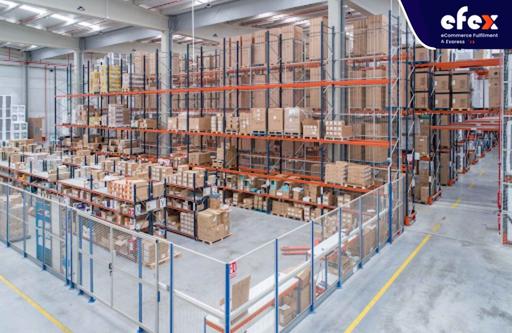
Every item in the warehouse has a fixed bin placement thanks to fixed slotting. Each bin is given a grade based on the lowest and maximum amount of the allocated item. When the container is too empty, reserve storage sends a refill order.
When things are randomly slotted, temporary pick locations are replaced by pick zones. Pickers are responsible for picking the products from another spot inside the zone if stock in one slot runs low. There is little or no reserve inventory held on hand, and all incoming receipts are sent immediately into pick areas.
Why choose one technique over another?
Although fixed slotting is a classic method of operation for the warehouse business, it might no longer be necessary. It can take a long time to replenish product slots reserve storage, and growing shipping quantities necessitate faster rates. Random slotting will be quicker since restocking takes much less time (even though pick areas could be bigger than fixed bin sites. Simply said, random slotting can necessitate a bigger warehouse.
>> Learn more: What is Dynamic Slotting in Warehouse? Benefits and Features
Facility managers must deal with micro slotting and macro slotting, which is the stage above fixed slotting and random slotting.
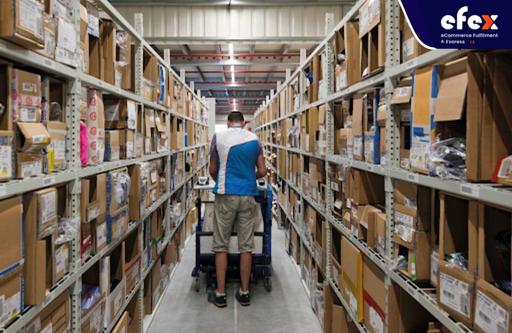
The placement of goods and pallets within picking areas is known as micro slotting. How should goods be arranged, for instance, on a certain shelf? Micro slotting has a big impact on the environment of the warehouse, especially in terms of employee safety and health. For instance, regularly putting bulkier products on lower shelves may require employees to bend down to pick them up, putting them at risk for repetitive stress injuries.
The facility manager needs to take their pick area layout into account while macro slotting. This layout is essential in a situation where consumers want a two-day shipment. Warehouses must therefore have high throughput systems with a minimum bottleneck at the receiving and loading zones. With regard to macro slotting and micro slotting, no "versus" element exists. Facility managers need to plan their warehouse while taking into account both realms. Businesses may significantly increase the performance of their warehouses if they gain both macro and micro slotting under control.
Successful slotting should result in not just an effective and optimal use of warehouse storage but also reduced handling levels and quicker travel times. According to some studies, effective slotting can reduce labor expenses by up to 20%. These are significant savings considering that order picking typically consumes around 40% to 60% of the labor hours used in warehouse operations. Improving your slotting doesn't need a significant investment in new tools or personnel.
We provide these five more justifications for warehouse managers to take a deeper look and reevaluate their warehouse slotting approach if you need to defend a project that examines your existing warehouse slotting:
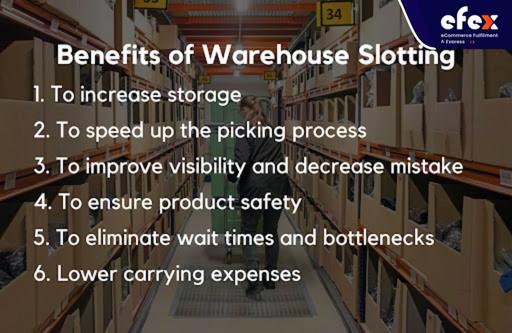
Have you ever noticed how a cluttered or messy room feels small? But after everything is put away, the space appears larger, despite the fact that the same amount of objects is there. Likewise, in a warehouse, the greater the slotting, the better organized it will be, and the more room you will have since the total area is used properly.
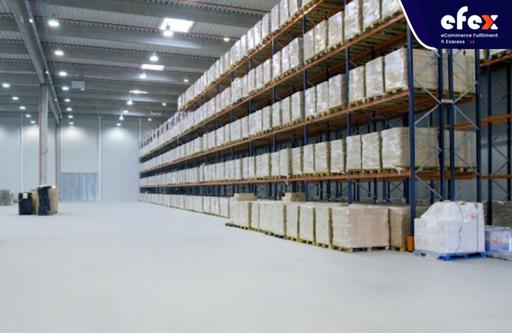
Slotting can be used to find areas where storage space can be increased. Rethinking how inventory is usually controlled is a good approach to reclaiming much-needed storage space if you believe your warehouse to be full.
Random slotting, as well as fixed slotting warehouses, must reduce the amount of inventory kept in prolonged storage while increasing the number of goods that can be picked and transported right away. If you take the effort to maximize your warehouse, you can put off expanding or incurring additional fees for a second warehouse. More space may be made available for the warehouse's more critical places thanks to an effective slotting process.
How often has an employee had to walk through a number of products that moved slowly in order to reach the ones that moved quickly? How frequently do your employees hurry back and forth along an aisle to gather products for an order? These two things above signal inefficiency. Replenish and picking take a shorter time to complete when goods are arranged in the most effective way.

In reality, one of the time-consuming aspects of these operations is moving between the locations of the items. By removing any misunderstanding for the picker, effective slotting may increase picking accuracy and speed. Faster picking is made possible by storing things in ways that make perfect sense for the employees such as by kind, weight, size, and so on, which eliminates the need to make guesses about where specific items are placed. Pickers may thus spend less time traveling and more time focusing on getting to the item quickly.
Employees might collect and deliver the item during the time they spend looking at their tablet or clipboard to find it. By enabling quick item location, good slotting increases staff productivity. It should make storing everything that belongs there easier. This procedure decreases the probability of mistakes by enabling facility managers and staff to recognize when a product is not in its proper location right away.
Facility managers can design a pick order that puts heavier products on the bottom of a pallet and lighter things on top using warehouse slotting. Thus, the potential of product damage during shipment is reduced and a safer pallet is generated. Making sure that goods are not damaged in transit or storage is essential in a warehouse setting. Correct item storage, such as storing perishable food in refrigerator-safe containers, is ensured by good inventory slotting. Thus, goods are delivered to customers in good condition.
How often has a picker been forced to halt while attempting to get a product as another picker is struggling with a large object, a forklift is in use, or a group of pickers is passing through the zone with fast-moving objects? It occurs far too frequently. The usage of warehouse slots makes it simpler for staff to choose and pack things. By making sure employees picking smaller goods don't frequently have to delay while somebody picks pallets with a forklift, you may lessen these traffic jams.
Every second that the inventory is not sent to a customer, it accrues a measurable cost of storage. In order to lower carrying costs, JIT (just-in-time) inventory methods emphasize the value of maintaining a small amount of stock. By boosting throughput, warehouse slotting reduces these expenses. Companies need to devote less time and cost keeping goods the more quickly they can control them.
👉 Read More: All Cost To Rent A Warehouse In 2024
The advantages of developing a robust warehouse slotting plan are obvious; however, where do you need to start? Managers can start designing a slotting method that optimizes their resources by utilizing the supply chain metrics below.
You may group certain things together for greater efficiency using this information, which also reveals yearly or seasonal variations in order volume.
The information provides the size and kind of merchandise that a given item represents. This aids managers in comprehending any specific directions for managing or keeping an object.
Whether picking occurs at the pallet, case, or personal level is the subject of this information. Additionally, it displays the storage device from which the item was selected.
Slotting might be difficult to implement at first but is crucial for effective warehouse management since it affects both inbound and outbound procurement. The most popular recommended practices to remember are listed below:
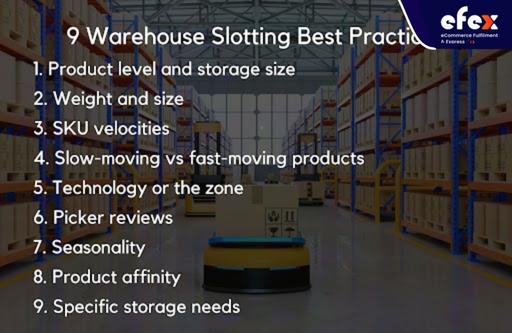
Whether a product is picked at the case level, the pallet level, or as a single piece should be taken into account when using a slotting strategy. A forklift or a cart may be needed to move a pallet or a case. Other employees in the areas will have to slow down as a result of these moves as they must avoid a temporary obstruction. High-level objects should cluster in places where they won't hinder other pickers, according to a sound approach.
SKU data frequently include details on an item's size and weight. The pick order should ideally place a heavier item first, therefore SKU information is essential. Additionally, employees must build cubes that don't surpass the boundaries of the pallet they are placing them on. Managers must thus emphasize how consistently shaped products improve packing effectiveness.
You can learn which products sell the quickest by looking at your order history. It reveals which products move slowly and which enter and leave the facility the fastest. Picking speed may be increased by combining things that move quickly and others that move slowly.
Fast-moving products are exactly what their names imply; they enter the warehouse swiftly and exit just as quickly. Keeping these things near the front of the facility is generally a good idea. Slow-moving products, on the other hand, require a longer time to shift around (sometimes weeks or months). Unless they are very heavy, in which case they can be picked first and serve as the base of the pallet, it's ideal to place them in the back of the facility.
There are no fixed bin placements in warehouses that are zone-organized. Instead, bins filled with perishable goods are placed in refrigeration zones, bins filled with cartoon figures are placed in the "toys" zone, and so on. Care should be taken to position things within these zones so that they are simple to reach. That necessitates taking into account the technologies required to get these goods, including forklifts, ladders, and more.
Managers ought to pay attention to their staff. Inventory pickers on the ground have access to information that data can never provide, and their recommendations assist enhance the warehouse atmosphere and boosting safety.
Time alters the velocity. A product that sells rapidly in the summer may not sell as well in the winter. Businesses can re-slot the warehouse as well as achieve optimal efficiency during a year by analyzing velocity statistics.
This practice is crucial since items like notebooks and pens or Christmas decorations and wrapping paper frequently ship together. When feasible, put items next to one another that are frequently sent together.
Cellphones, jewelry, and other valuables make for attractive prey for theft. Grouping these things in a fenced area will allow you to keep track of who comes and goes. Food that spoils quickly should be kept in perishable areas, and possibly dangerous materials should be kept in separate storage. Managers need to make sure that they train all pickers on how to handle risky or temperature-sensitive goods safely.
Since there are so many things that need to be managed, it may be difficult for administrators to handle fluctuating priorities. Nowadays, a lot of facilities managers find the help of software for direction.
The "ABC" approach is one simple slotting algorithm.
This approach only uses order history data to estimate item velocity. Every item ordered in the past 30 days is typically gathered together with its SKUs
Then, these goods are divided into groups, with group A receiving 50% of the products with the highest line orders, group B receiving the next 25%, and group C receiving the last 25%. Group A items are placed closest to the door.
The ABC technique is useful when warehouses manage bigger SKU numbers and higher inventory turns. There are additional factors besides velocity that justify giving one thing priority over another. Software is the sole option available to facility managers as they cope with the growing complexity of warehouse slotting.
To effectively optimize the warehouse, facility managers can specify the dimensions of their storage containers, build putaway or pick sequences, as well as integrate this data with demand estimates. That allows warehouse managers to concentrate on their primary skills by delegating the job of warehouse slotting.
Slotting in the warehouse may be effective, but not by itself. To support the slotting operation to its greatest capacity, the warehouse facility must adhere to certain requirements.
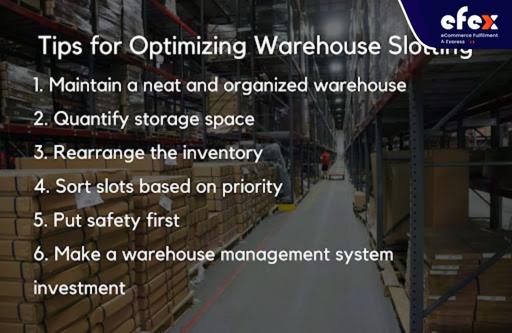
At the slot level, slotting entails organizing, but there is more to it than that. Slotting functions that much better when bins have labels, products stack neatly, and there isn't abandoned packaging debris blocking up aisles.
Managers must also take macro-slotting into account for warehouse slotting to be effective. This implies that the warehouse's structure must make use of the available space. That guarantees that factors like overstocking or understocking never cause the slotting process to falter.
Keep in mind that the slotting process has other objectives besides only speed. Not only should it be simple to reach a certain shelf, but it should also be simple to locate an item on that shelf. Consequently, elements like labeling and organizing must also be focused
The slots nearest to the loading dock, for instance, are typically more important than the spaces at the back. Several warehouse slots are much more significant than others. The most crucial roles must be filled first.
Similar to this, managers should never compromise safety for speed. Ensure that staff is trained to handle heavy and hazardous products, that slot materials can withstand frequent heavy use, and that they are kept out of the way of forklifts.
Facility managers can greatly benefit from using warehouse management systems (WMS) to improve the warehouse optimization technique. A WMS may produce insights that people alone would not reach by combining data from many areas of the warehouse, such as SKUs, order history, and picking level.
Your warehouse activities can be done more effectively with the help of a slotting warehouse, which will ultimately result in lower logistics costs. It could be time to transfer to a 3PL if you are presently self-fulfilling orders and controlling inventory inside your own warehouse. Best-in-class fulfillment technology is used by Efex to support a powerful fulfillment network. Please get in touch with us if you need support. Good you have a good time with EFEX - eCommerce Fulfillment & Express.


